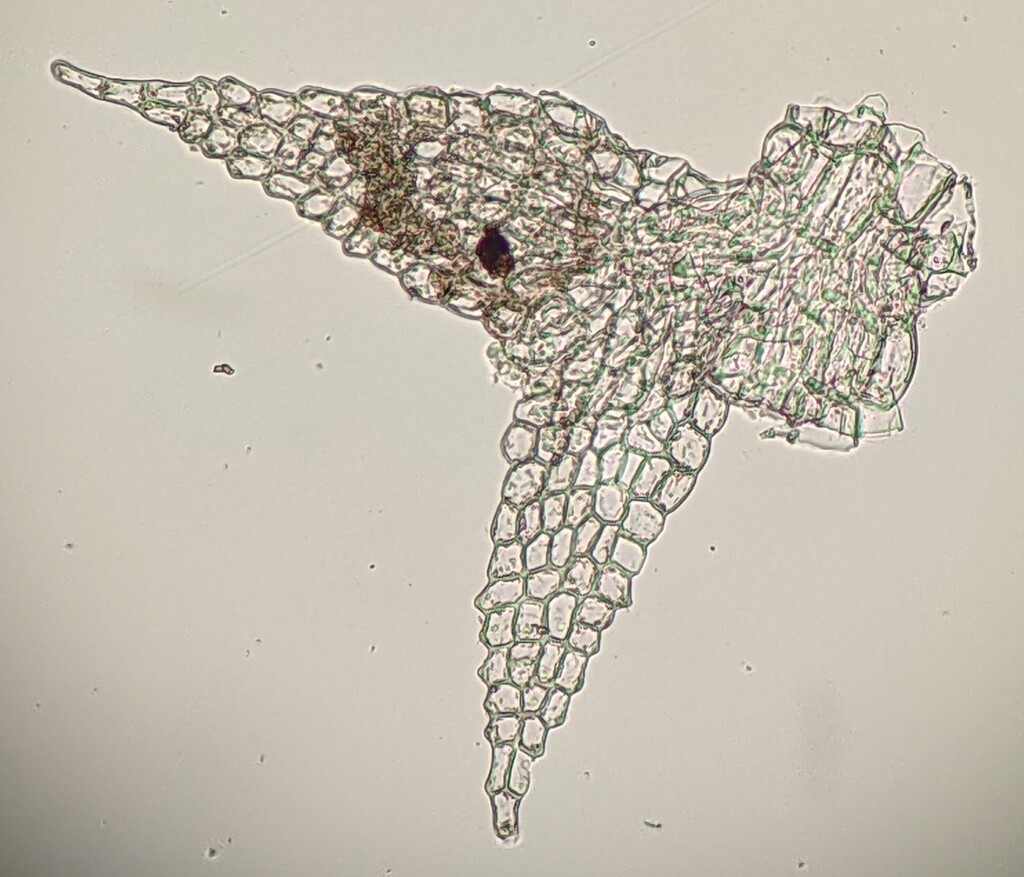Colura pulcherrima
Jovet-AstCreeping on ferns fronds, pale yellowish-green when dry, monoicous. Specialised asexual propagules absent. Lateral leaves distant to imbricate, widely spreading from stem, 525–1100 µm long, 225–375 µm wide; lobe 250–500 µm long, with a basal semicircular, explanate section, clasping the stem, 100–300 µm wide, becoming cylindric towards leaf apex; lobule larger than lobe, cylindric at base of leaf, abruptly dilating into ovoid, inflated sac and forming the widest part of leaf, acute to obtuse at apex; lid covering lobule opening attached to a series of specialised hinge cells and moveable; cells polygonal and isodiametric to oblong, 17–33 µm long, 10–20 µm wide, without trigones or intermediate thickenings, with several ellipsoid botryoidal oil bodies, those of lobule thin-walled, each with a prominent papilla, except sometimes toward base, those of lobe, evenly firm-walled, occasionally with papilla less-prominent than lobule in basal section, becoming uniformly papillose in cylindric section toward leaf apex; margin crenulate by projecting cells in basal section of lobe or crenulate by projecting papillae, papillae becoming especially prominent near leaf apex. Underleaves one to each lateral leaf, V-shaped, with two widely divergent lobes, 90–350 µm long, 87–250 µm wide, distant; lobes narrowly lanceolate or narrowly-triangular, 55–255 µm long, 4–8 cells wide at base; cells polygonal and isodiametric to oblong, 17–43 µm long, 12–20 µm wide, evenly firm-walled, without trigones or intermediate thickenings, mostly smooth, scattered cells, especially toward apices, with single papillae less prominent than on cells of lateral leaves, those at margins projecting forming a crenulate margin, especially toward apices; apices acuminate, formed by a single row of cells. Androecia terminal on short lateral branches, of 3–4 pairs of elliptic bracts with lobules. Female bracts not forming lobules, asymmetrically ovate to oblong, tightly enveloping base of perianth, 240–360 µm long; cells each with a prominent papilla similar to cells of lobule. Perianth obconic to cylindric-obconic, stipitate, 550–1100 µm long, 325–600 µm wide, with 5 obscure, rounded longitudinal ridges, ending in beak at mouth that separates into teeth formed by a single row of cells along mouth; cells mostly polygonal and isodiametric, 10–25 µm diam., each with a prominent papilla similar to cells of lobule and prominently crenulate along margins from papillae. Spores usually multicellular, 65–100 µm long, 20–50 µm wide, covered with fine tubercles, when unicellular c. 30 µm long, c. 25 µm wide.
Recorded once in Victoria from near Powelltown.
The identity of this species is uncertain. The Victorian collection was identified by G.A.M. Scott as C. pulcherrima var. bartlettii. Lateral leaves in the illustrations of C. pulcherrima in Jovet-Ast (1953) closely resemble the Victorian plants, most importantly they both share acute to obtuse apices, which is one of the two characteristics used by Jovet-Ast (1953) in an identification key to distinguish this species from the similar C. saccophylla. However, the other character used to distinguish the two species is whether the underleaves have margins with protruding cells, and for this character the Victorian plants tend to have protruding cells that according to Jovet-Ast (1953) matches C. saccophylla. The Victorian plants are tentatively left in C. pulcherrima here based on the overall more similar appearance to C. pulcherrima. Close inspection of type material is required to resolve this uncertainty.
Jovet-Ast, S. (1953). Le genre Colura. Revue bryologique et lichenologique 22: 206–312.
 Spinning
Spinning